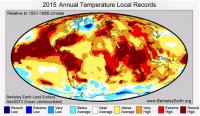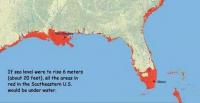-
Aliens may be building megastructures around a star to harvest energy: Astrophysicists

There is something strange happening with a star named KIC 8462852, leading astronomers to suggest that perhaps what we are witnessing is a huge alien megastructure being built around the star. Scientists last year said that KIC 8462852 appeared to be getting darker with no clear or obvious explanation. Some went on to suggest that the flickering and dimming of the star were the result of an alien megastructure being built around it. The purpose of the megastructure? Energy harvesting.
-
-
Worst flooding since 1998 leaves $33 billion economic toll in China

The new Global Catastrophe Recap report, covering July 2016 disasters, reveals that much of China endured substantial seasonal “Mei-Yu” rainfall that led to a dramatic worsening of flooding along the Yangtze River Basin and in the country’s northeast. Total combined economic losses were estimated at $33 billion. Meanwhile, the United States recorded six separate outbreaks of severe convective storms and flash flooding from the Rockies to the East Coast. Total combined economic losses were minimally estimated at $1.5 billion. Only 2 percent of China damage is covered by insurance, compared to nearly 70 percent for U.S. storms.
-
-
Melting ice sheet could release frozen cold war-era radioactive waste
Camp Century, a U.S. military base built within the Greenland Ice Sheet in 1959, was decommissioned in 1967, and its infrastructure and waste were abandoned under the assumption they would be entombed forever by perpetual snowfall. But climate change has warmed the Arctic more than any other region on Earth, and as portion of the ice sheet covering Camp Century melt, the camp’s infrastructure will become exposed, and any remaining biological, chemical, and radioactive waste could re-enter the environment.
-
-
Making climate change summaries suitable for “grownups,” but accessible to policymakers
Researchers examined the writing and editing procedures by which the Intergovernmental Panel on Climate Change creates summaries of their findings for policymakers. Despite recent critiques that these summaries are too difficult for non-experts, the researchers found them comparable to reference texts in terms of reading comprehension level. Nevertheless, the researchers also suggest ways that the summary reports could be improved by using less jargon and more cohesive language to link the ideas they contain.
-
-
Adaptation to climate risks: Political affiliation matters
A new study reveals that those who affiliate with the Democratic Party have different views than those who vote Republican on the following issues: the likelihood of floods occurring, adopting protection measures, and expectations of disaster relief from the government.
-
-
2015 surpassed 2014 as the warmest year since at least the mid-to-late nineteenth century

A new State of the Climate report confirmed that 2015 surpassed 2014 as the warmest year since at least the mid-to-late nineteenth century. Last year’s record heat resulted from the combined influence of long-term global warming and one of the strongest El Niño events the globe has experienced since at least 1950. The report found that most indicators of climate change continued to reflect trends consistent with a warming planet. Several markers such as land and ocean temperatures, sea levels, and greenhouse gases broke records set just one year prior.
-
-
Climate risk and the fossil fuel industry
Burning coal, oil, and natural gas is responsible for two-thirds of the world’s greenhouse gas emissions. Yet these same fuels are also the economic mainstay of resource-rich countries and the world’s largest companies. According to a new study, this means that climate-change relief actions represent danger for the fossil fuel business.
-
-
Electric grid vulnerabilities in extreme weather areas
Climate and energy scientists at the DoE’s Oak Ridge National Laboratory have developed a new method to pinpoint which electrical service areas will be most vulnerable as populations grow and temperatures rise. The scientists’ integrated approach – combining ORNL’s unique infrastructure and population datasets with high-resolution climate simulations run on the lab’s Titan supercomputer — identifies substations at the neighborhood level and determines their ability to handle additional demand based on predicted changes in climate and population.
-
-
Sea-level rise threatens many coastal U.S. military bases

The U.S. Armed Forces depend on safe and functional bases to protect the U.S. national security. Sea levels are rising as global warming heats up the planet, and many military bases along the U.S. East Coast and Gulf of Mexico are at risk of permanently losing land to the ocean in the decades ahead. As the seas rise, high tides will reach farther inland. Tidal flooding will become more frequent and extensive. When hurricanes strike, deeper and more extensive storm surge flooding will occur. The United States must thus prepare for the growing exposure of its military bases to sea level rise.
-
-
Warmings greater than 1.5 °C inevitable owing to current atmospheric greenhouse concentrations
Current levels of atmospheric greenhouse gas concentrations already commit the planet to air temperatures over many land regions being eventually warmed by greater than 1.5°C, according to new research. The results of the new study have implications for international discussions of what constitutes safe global temperature thresholds, such as 1.5°C or 2°C of warming since pre-industrial times. The expected extra warming over land will influence how we need to design some cities. It could also impact on the responses of trees and plants, including crops.
-
-
Climate disasters increase risk of armed conflict in multi-ethnic countries
Climate disasters like heat-waves or droughts enhance the risk of armed conflicts in countries with high ethnic diversity, scientists found. Each conflict is certainly the result of a complex and specific mix of factors, but it turns out that the outbreak of violence in ethnically fractionalized countries is often linked to natural disasters that may fuel smoldering social tensions.
-
-
New research predicts a doubling of coastal erosion by mid-century in Hawai’i
Chronic erosion dominates the sandy beaches of Hawai’i, causing beach loss as it damages homes, infrastructure, and critical habitat. Researchers have long understood that global sea level rise will affect the rate of coastal erosion. Newresearch team developed a simple model to assess future erosion hazards under higher sea levels.
-
-
Cape Cod susceptible to potential effects of sea-level rise
Cape Cod is vulnerable to rising water tables and, in some areas, groundwater inundation as a result of rising sea levels, according to a new U.S. Geological Survey study (USGS). Groundwater inundation occurs when the water table reaches or exceeds land surface. The challenges associated with the issue are likely to become more prevalent as seas rise. Depending on the severity, it may make areas unsuitable for residential and commercial development.
-
-
Managing the endangered Rio Grande River across the U.S.-Mexico border

The Rio Grande (called Rio Bravo in Mexico) is the lifeline to an expansive desert in the southwest United States and northern Mexico. From Colorado to the Gulf of Mexico, over 3,000 km, people depend on the river to quench their thirst and irrigate their crops. Yet as the river flows from the United States, it brings with it conflicts and challenges. The water level in the river is declining as use exceeds supply. Water demand is rising as the population in the region grows, and corresponding economic growth drives continued development. Moreover, climate change is expected to lower water levels even further, exacerbating the problems.
-
-
Breaking records: The first six months of 2016 the warmest half-year on record
Two key climate change indicators — global surface temperatures and Arctic sea ice extent — have broken numerous records through the first half of 2016. While these two key climate indicators have broken records in 2016, NASA scientists said it is more significant that global temperature and Arctic sea ice are continuing their decades-long trends of change. Both trends are ultimately driven by rising concentrations of heat-trapping carbon dioxide and other greenhouse gases in the atmosphere.
-
- All
- Regional
- Water
- Biometrics
- Borders/Immig
- Business
- Cybersecurity
- Detection
- Disasters
- Government
- Infrastructure
- International
- Public health
- Public Safety
- Communication interoperabillity
- Emergency services
- Emergency medical services
- Fire
- First response
- IEDs
- Law Enforcement
- Law Enforcement Technology
- Military technology
- Nonlethal weapons
- Nuclear weapons
- Personal protection equipment
- Police
- Notification /alert systems
- Situational awareness
- Weapons systems
- Sci-Tech
- Sector Reports
- Surveillance
- Transportation
Advertising & Marketing: advertise@newswirepubs.com
Editorial: editor@newswirepubs.com
General: info@newswirepubs.com
2010-2011 © News Wire Publications, LLC News Wire Publications, LLC
220 Old Country Road | Suite 200 | Mineola | New York | 11501
Permissions and Policies
Editorial: editor@newswirepubs.com
General: info@newswirepubs.com
2010-2011 © News Wire Publications, LLC News Wire Publications, LLC
220 Old Country Road | Suite 200 | Mineola | New York | 11501
Permissions and Policies
